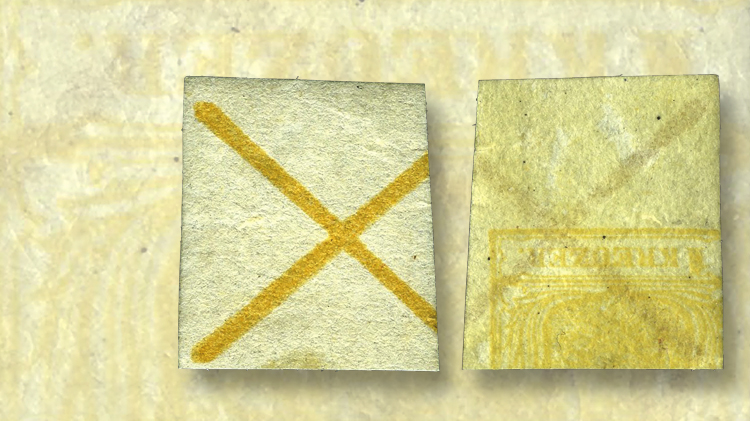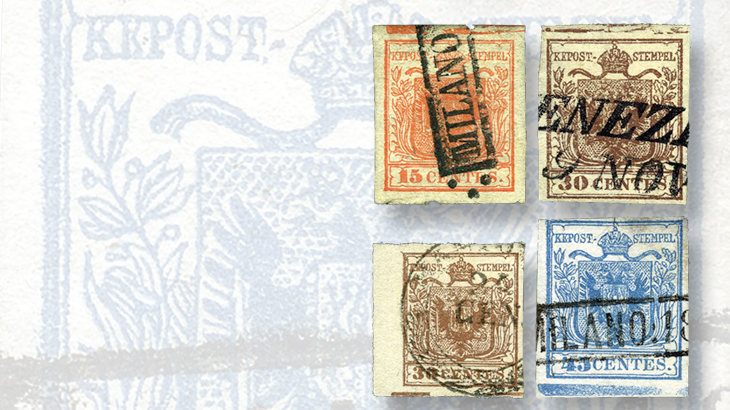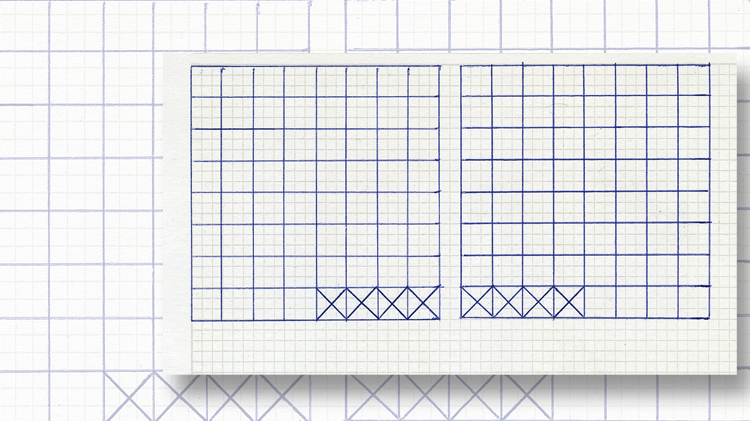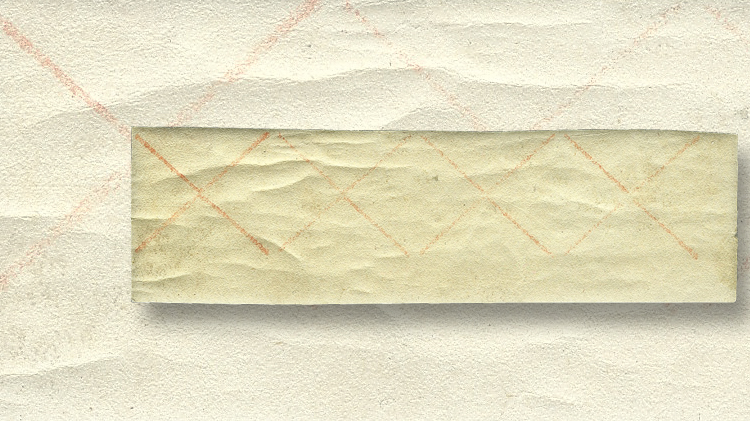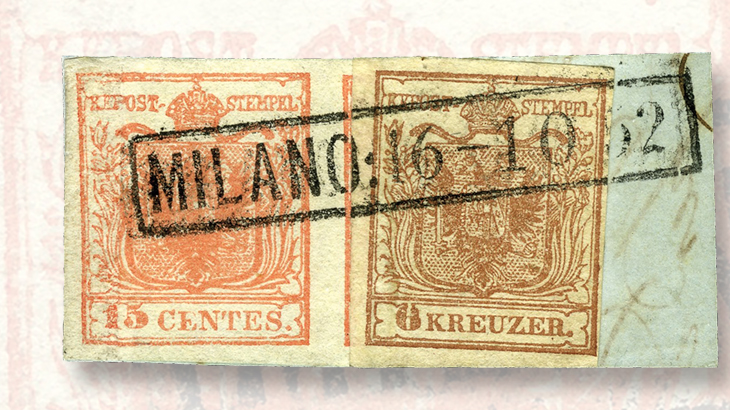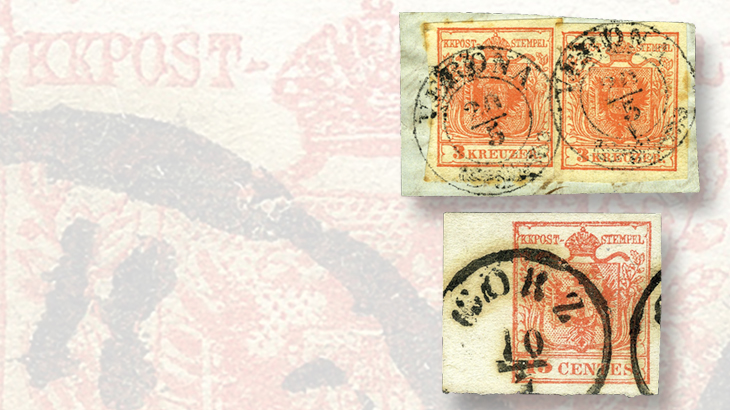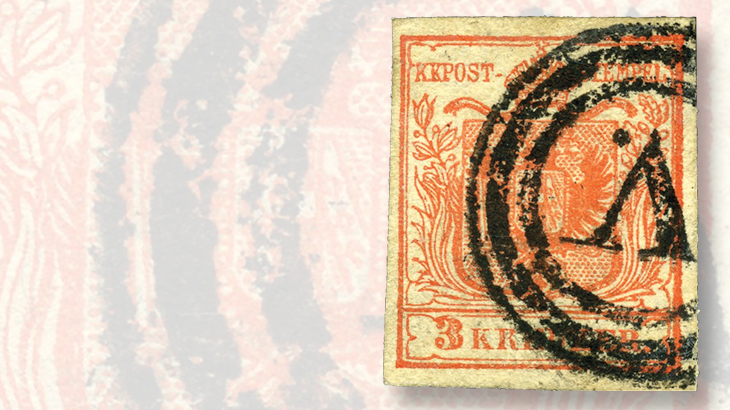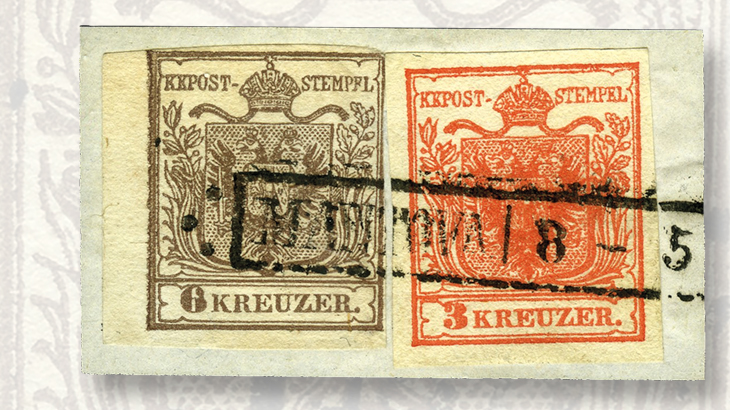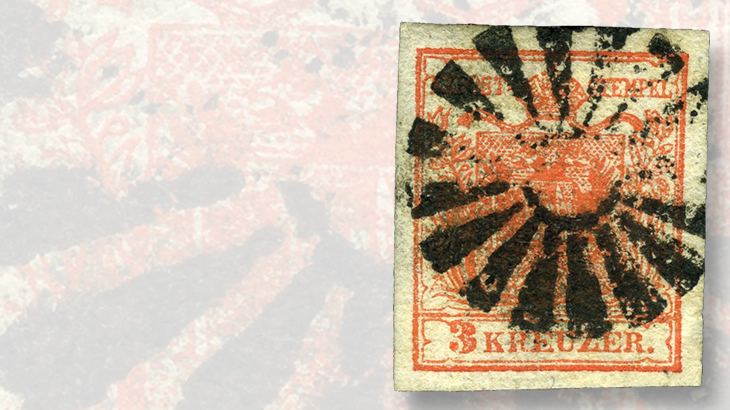World Stamps
The quads, crosses and costs of the first Austria and Lombardy-Venetia stamps
By Sergio Sismondo
Editor’s Note: This is Part 3 of Sergio Sismondo's series on the first stamps of Austria and Lombardy-Venetia. Part 1, which introduces the stamps and explains different types and colors, can be found here. Part 2 focuses on aspects including paper, paper thickness, watermarks, and sheet margins, and can be found here.
Raised Quads
The Oxford English Dictionary explains that a quad is a small metal block in various sizes, lower than type height, used by letterpress printers for filling up lines. For stamp printers, quads are used to define and maintain distances between stamps, both vertically and horizontally. Quads vary in thickness, and vertical separations are wider than horizontal separations.
Connect with Linn’s Stamp News:
Sign up for our newsletter
Like us on Facebook
Follow us on Twitter
Normally quads do not make impressions. This is because they are positioned lower than type, and therefore do not touch the ink source nor the paper. However, if they rise above their intended positions, they can pick up ink and leave impressions. Usually such impressions are rectangular, of 1.4-millimeter width, forming parts of an additional and unplanned frame to the stamp. The vast majority of them are horizontal, at top or bottom of the stamp.
These impressions have come to be known as “raised quads” (in German “balken,” and in Italian “spazi tipografici”). Stamps of the first issues of Austria and Lombardy-Venetia show raised quads more often than typographed classic stamps of other countries. Still, they are not common, are avidly sought by collectors, and command substantial premiums.
The first image shows raised quads at top or bottom of the stamps. Values range widely with quad impressions along the full width of the stamp being the scarcest and with greater value. In all four cases illustrated here, the quad impressions span the entire width of the stamp.
Related rarities are stamps with raised quads both at top and bottom, and stamps with vertical raised quads. Covers are another matter. On covers, Lombardy-Venetia stamps in a grade of fine with single raised quads fetch in auctions between $400 (15 centesimi) to about $4,000 (10c machine paper). For Austria, raised quads on cover range from $350 (3 kreuzer) to about $2,000 (2kr machine paper).
St. Andreas Crosses
Austria and Lombardy-Venetia stamps were printed in sheets of 240 stamps, arranged in four panes of 60 stamps each. Each pane had eight rows of eight stamps each. Because 64 stamps in each pane would have complicated their arithmetic, four positions in each pane were filled in with crosses, which soon became known as St. Andreas crosses.
Several differing compositions exist in which the position of the four crosses varies from left to right, always on the lower row of each pane. The nearby image shows the arrangement of stamps and crosses in two panes from the second composition.
Two types of St. Andreas crosses exist: the first has thicker lines, and the second has much thinner and less regular lines. Shown here is a very scarce complete strip of four crosses from a Lombardy-Venetia 15c sheet. It shows clearly the sheet margin at bottom and at right.
It is from an 1854-1858 printing on machine-made paper. The combination of the two features assures us that it is from the second composition.
The vast majority of St. Andreas crosses ended in the rubbish bins at post offices. Nobody knows how many sheets of these stamps were printed, and there is only a vague idea of how many crosses have survived. We can say for sure that complete crosses are rarities; any complete cross attached to a sound stamp will fetch from $35,000 and upward.
Because few collectors can afford such a stamp (and even if many could, there would not be a sufficient number of examples to please all), the market adjusted and created strong demand for parts of crosses attached to stamps. They are measured in millimeters. A stamp may have at right, left, or at bottom the beginning of a cross. If the stamp is cut rectangularly, two parts of a cross may be seen, both of the same length. If the stamp is cut obliquely, the measurement is taken of both parts, and the shorter one is used to define the stamp’s value.
Beginning with 1mm of St. Andreas cross, values for fine stamps start at about $75 for a 3kr or 15c stamp. For all the other denominations and scarcer types, values are between $100 and $375. For 2mm parts of a cross, the values are doubled. For stamps with 3mm of a cross, they are doubled again, and so forth. It is easy to see how we can reach $35,000 for complete crosses attached to stamps. Such values attest to the high demand and extremely low supply of stamps with St. Andreas crosses.
An extraordinary example of a St. Andreas cross is shown with this column. This is a single cross on one side, printed in a deep shade, and on the reverse is part of a stamp and part of a cross. Given the composition of the sheets adopted by the Austrian printers, such a strange “stamp” necessarily exists. Its rarity, no doubt, is extreme.
It is also interesting that if it were found undescribed among a group of early stamps, a poorly informed collector might just toss it aside as irrelevant. Preferably, the item could go in a back-of-the-book page of cinderellas, to be rediscovered and studied at a later time. And speaking of cinderellas, St. Andreas crosses in singles or multiples are found on the reverse side of covers, conveniently used as seals. Such covers, far from being insignificant, also command substantial premiums.
Cross-Border Usages
Colors of stamps for use in Austria and Lombardy-Venetia were the same for equivalent denominations, and served for the same postage rate, as described here:
1kr or 5c yellow, printed matter under 17.5 grams (1 Viennese loth)
2kr or 10c black, city letters and district letters under 17.5 grams
3kr or 15c red, internal letters under 17.5 grams, less than 75 kilometers
6kr or 30c brown, internal letters under 17.5 grams, less than 150 kilometers
9k, or 45c blue, internal letters under 17.5 grams, less than 225 kilometers
For the purpose of this discussion, what is apparently obvious is that stamps denominated in kreuzer could easily be confused for stamps of the equivalent value denominated in centesimi and vice versa. Aside from the denomination, the stamps were for all practical purposes identical. In other words, we would expect to find a good number of letters franked with Lombardy-Venetia stamps used in Austria and Austrian Empire territories, and also a good number of letters franked with kreuzer-denominated stamps used in Lombardy and in Venetia.
However, the stamps were really not the equivalent of each other because the Austrian lira was worth somewhat less than the Milano lira. To be precise, 1 Austrian lira was worth 0.865 Milano lira (1 kreuzer = 4.35 Italian centesimi.) That was a substantial difference, and it led to abuse as Lombards and Venetians took advantage of buying stamps in Austria to frank their letters in Italy.
But soon the Austrian overlords decreed the practice to be illegal, beginning May 28, 1851. That decree seems not to have made much difference. Austrian stamps continued to be used in Lombardy-Venetia.
 9 Important Steps to Succesfully Soak Stamps: You can get a stamp collection going with just a few things most everyone can find around their home.Sign up for our free newsletter and we'll give you instant access to our exclusive Linn's Stamp News report.
9 Important Steps to Succesfully Soak Stamps: You can get a stamp collection going with just a few things most everyone can find around their home.Sign up for our free newsletter and we'll give you instant access to our exclusive Linn's Stamp News report.
A much smaller number of Lombardy-Venetia stamps were used in Austria. The fact that 45c in Milano was worth more than 9kr in Austria was the significant factor in explaining the difference in usage. Italians could gain by using the incorrect stamps. In the opposite direction, no gain could be made.
As we would expect, stamps of Lombardy-Venetia used in Austria are much scarcer than stamps of Austria used in Lombardy-Venetia. Although, we might add that many Lombardy-Venetia stamps were used in Austrian territories in the Dalmatian archipelago, and Italian-language communities such as Pola, Fiume,Trieste, Zara, and many others for the simple reason that ship captains and ship pursers, who visited these lands daily or weekly, carried Lombardy-Venetia stamps in their strongboxes or wallets and would sell them to passengers as needed.
The Scott Classic Catalogue of Stamps and Covers 1840-1940 lists in the Austria section stamps used in Lombardy-Venetia, and gives minimum values for singles and covers. In the section on stamps in Lombardy-Venetia, it lists stamps used in Austria, and gives minimum values for single stamps and covers. All such values followed the word “from” because the value varies enormously depending on the town where the stamp was used.
Minimum values are for stamps with legible Milano and Venezia cancellations, and on the other side of the border for stamps with cancellations of Wien, or Brun and a few other large cities. Cancellations from small towns and villages are worth a great deal more.
Even single stamps with good strikes can reach up to $5,000 — “Arcisate,” for instance, struck on an Austrian stamp. Nearby are two examples of fairly common usages: Verona on 3kr red, and Gorz on 15c red.
The next two illustrations are of much rarer stamps. First is a combination of 3kr red and 6kr brown stamps used at Mantova — a most uncommon pair of stamps (from the home of the Victor Hugo-inspired Rigoletto opera by Giuseppe Verdi).
The other image is a fragment bearing two examples of the 3kr red, the left one with raised quads both at top and bottom, tied by a rectangular framed postmark of Venezia, (home of Willian Shakespeare’s Othello, The Moor of Venice) and canceled on the first year of issue. It is unbelievably rare.
Even more prestigious and sought after are fragments or letters with combinations of Austrian and Lombardy-Venetia stamps. Shown nearby is one such combination: Lombardy-Venetia 15c red and Austria 6kr brown. Such a combination on fragment of a letter may be worth about $3,000. A full cover bearing such a combination may fetch on the order of $30,000. The rarest combinations on cover, such as the “twin stamps” 45c blue with 9kr blue, have reached realizations of $250,000.
Mute Obliterators
There is room for one more interesting detail regarding the Austrian Empire’s stamps of 1850. Sometime in late 1850 a postal inspector determined that the cancellations on stamps were not heavy enough, opening the possibility of fraudulent second use of stamps. The department decided to launch an experiment in heavy postmarks, which in other countries were called “obliterators,” or “killers,” but in this context became known as “mute.”
The experiment consisted in giving each of 16 busier post offices a distinctive handstamp destined to be applied on the stamps, while the dated town marking would continue to be applied elsewhere on the envelope.
The experiment lasted a few months but was soon discontinued (apparently at different times in different towns). The reasons for and against the new devices are not recorded, so we do not know the reasoning behind the discontinuation. We can assume that the extra time it took to apply two handstamps on the envelope instead of one was judged to cost more money than the tiny number of fraudulent frankings that passed undetected through the mail.
Be that as it may, the 16 obliterators are rather attractive and make a nice collecting area. They are also scarce, and worth looking out for. From Milano, the largest city in the territory, a fine strike on a fine stamp may fetch $250. From Venice, it may be worth about the same or somewhat less. Some of the other mutes fetch thousands of dollars. The mute cancellation from Monza, a small locality near Milano, for instance, admittedly being a much fancier marking, would today fetch as much as $4,000 for a fine strike on a single fine stamp.
The same obliterators struck on stamps of Austria instead of Lombardy-Venetia, which were prohibited by the directive of May 1851, are definitely rare and worth much more. Shown nearby are two examples of the mute cancellations on the proscribed 3kr stamps of Austria. The first example is from Milano, in the form of a cogwheel or fan, and the second example, from Venezia, has three concentric rings with a large “V.” in the center.
With this note I will stop, although there are still many subjects regarding these stamps, their history, and their postal history that could be discussed. Perhaps we will revisit the subject of Austrian first issue stamps and postal history in a future article.
Thus we bring to a close the articles for 2016, with which we have attempted to give readers information about where and how to look for worthwhile and valuable varieties in the first stamp issues of 1843 to 1850. It is our intention to continue in 2017 with descriptions of more stamps issued by European kingdoms, principalities, grand duchies, and duchies in 1850, beginning with the unified Kingdom of Spain.
Read the first two parts of this series:
 The first-issue stamps of Austria that set the standard for Europe: Stamps were simple in the Austro-Hungarian Empire even though the empire housed 11 ethnic groups and 18 principal languages.
The first-issue stamps of Austria that set the standard for Europe: Stamps were simple in the Austro-Hungarian Empire even though the empire housed 11 ethnic groups and 18 principal languages.
 Learning more about the Austria and Lombardy-Venetia stamps: Covering the papers, imperfections of typographical impressions, offset prints, and watermarks of the classic stamps.
Learning more about the Austria and Lombardy-Venetia stamps: Covering the papers, imperfections of typographical impressions, offset prints, and watermarks of the classic stamps.
MORE RELATED ARTICLES
Headlines
-
US Stamps
Oct 7, 2024, 3 PMMcMurtrie dismissed as APS education director following Sept. 21 arrest
-
US Stamps
Oct 7, 2024, 12 PMVasiliauskas named president of Mystic Stamp Co.
-
US Stamps
Oct 6, 2024, 5 PMApgar souvenir card available
-
US Stamps
Oct 6, 2024, 4 PMFirst Continental Congress and U.N. stamps receive Scott catalog numbers
